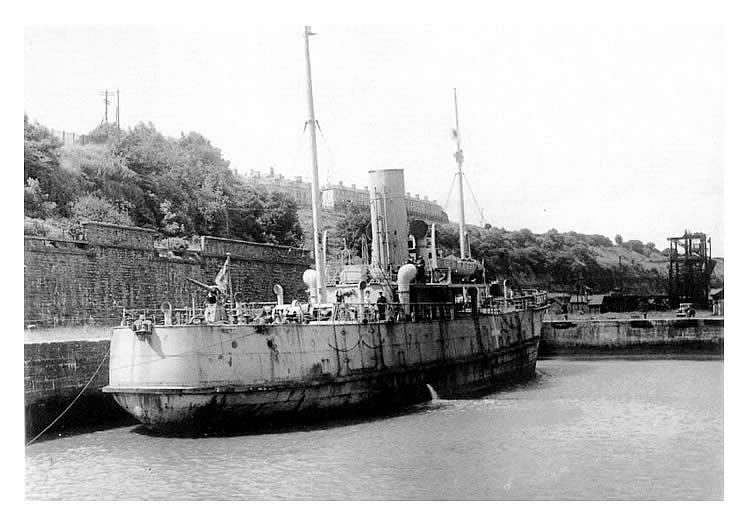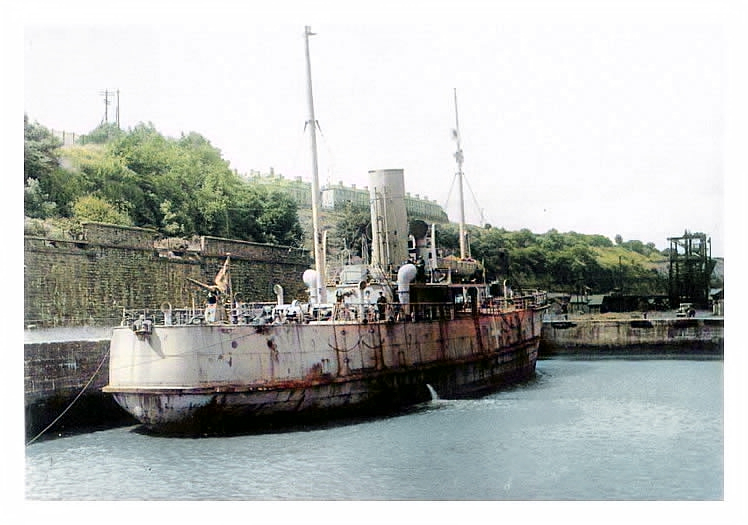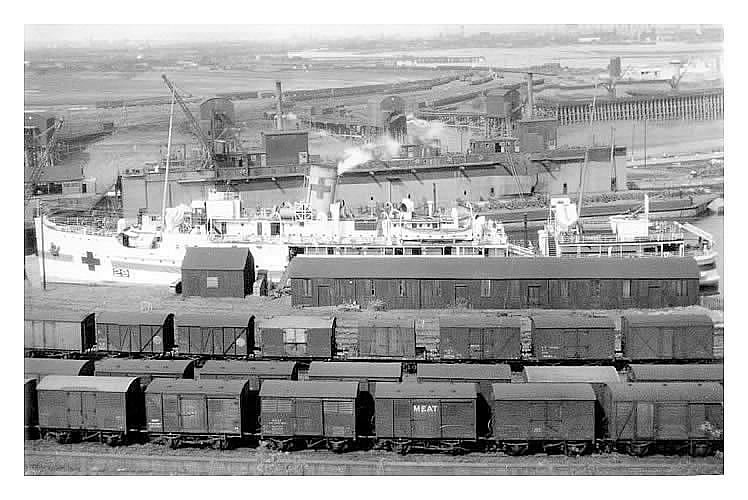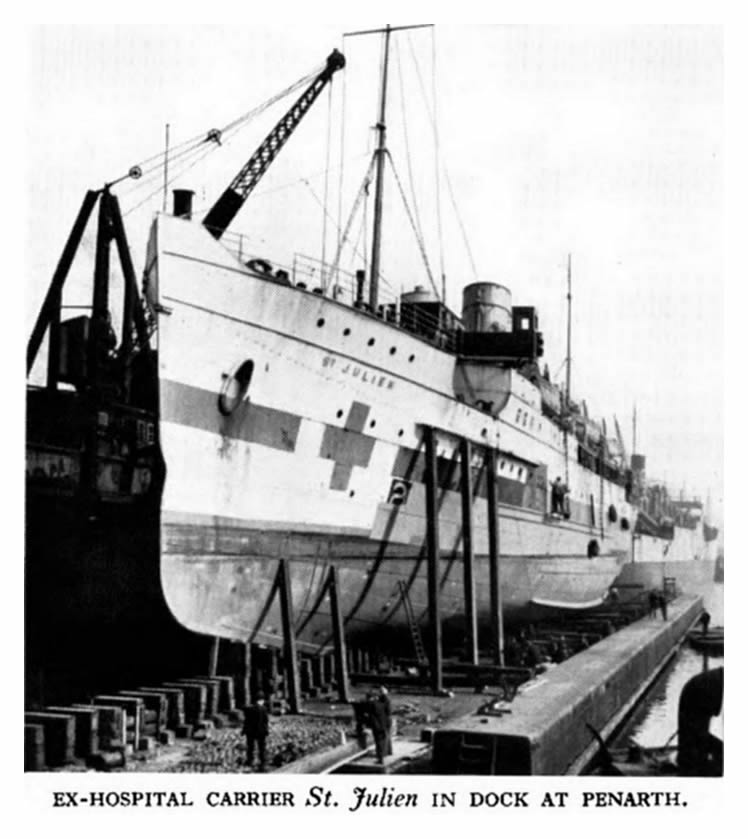 |
 |
In 1940, the S.S. 'Roebuck' was in Penarth Basin prior to repair on the pontoon. Damage was sustained at St Valerry-En-Caux on 13th June during the evacuation of the 51st Highland Division who were part of the British Expeditionary Force at the time. It cost the lives of three of her crew and seriously injured two others. She was lightly armed with only the gun mounted (and clearly visible) at the stern for protection. The image has also been colourised.
She was repaired and left for Penarth on the 24th June where she was refitted as a barrage balloon escort ship and following this was commissioned into the Royal Navy as H.M.S. 'Roebuck' on 22nd November 1940 and departed Penarth in December for escort duties in the English Channel. A second ship was also refitted at Penarth and commissioned as H.M.S. 'Sambur'. This information came from "Weymouth to the Channel Islands - A Great Western Railway Shipping History" by B. L. Jackson - an excellent read. Penarth pontoon must have been a busy place then and vital to the war effort. [105] [106] [255]
The Great Western Railway Magazine of January 1946 [1348] [1349] published an article entitled 'The Great Western Navy at War' and the following except is relative to Roebuck : -
Roebuck was a Channel Islands cargo vessel. On May 29, 1940, she unloaded her last tray of produce at Weymouth and was rushed off to Dover, without even waiting to ship any scaling ladders or other equipment. Two days later she was rammed astern by a destroyer, but went right on. Not being degaussed, Roebuck was unprotected against magnetic mines, but braved these and survived ; threading her way among unmarked wrecks, some - wholly submerged, while many others lay beached high and dry and burnt out, she came at last to Dunkirk. She had no proper gangway or ladders, but improvised some and, under fire from a battery, brought off 570 men, including 119 wounded.
Two Sister Ships at Arromanches
After an interval just long enough for one more trip to Guernsey and back, Roebuck was requisitioned again, in company with her sister ship Sambur, for more evacuation duty further west in the Channel. At the rendezvous at St. Valery-en-Caux they found the Germans in possession of the coast and themselves under terrific fire from the batteries. Both crews suffered casualties — some fatal — and both ships took a battering. After repairs they were taken into full naval service, and eventually found themselves in the armada for the invasion of the Continent.
Before D-Day, however, Roebuck suffered in a collision with a monitor in a dense fog. She made port under her own steam and rejoined the fleet after repairs. Sambur and Roebuck both helped to manoeuvre the huge concrete units built to form the amazing temporary harbour of Arromanches. Then they carried bridgework, cranes, dredger spares and other vital cargoes, braving bombs, rockets, shellfire, mines and submarines (including the “ one-man ” and “ two-men ” types) and sometimes steaming perilously close to other ships ablaze. These two doughty little cargo ships returned to the Company late in 1945.
|
| |
 |
 |
An image (with colourised version) dating from June 1944 with the 'St. Julien' hospital ship (No.29) moored at the southern quay opposite the pontoon. It is said that she steamed over 30,000 miles in the Mediterranean and carried over 90,000 patients during her activities there during WWII. She arrived at Penarth from Taranto on the 20th April 1944 where she underwent a refit which was complete by the end of May 1945. She resumed her role ferrying injured men, returning American and Canadian soldiers and German prisoners of war soon afterwards. [255]
The empty pontoon behind her with the iron ore wharfs more distant on the river Ely and far distant, the entrance to Cardiff Bute docks with its landmark pierhead building. In the sidings, in the foreground, the numerous coal wagons seen in previous images are now substituted with goods wagons including a “meat” wagon for the war effort. [061]
|
| |
 |
A pencil sketch by an unknown artist depicting the 'T.S.S. St. Julien in Dry Dock at Penarth Pontoon' dated c.1940. From the above mid-image it could be surmised that she had undergone repair to her hull plating on the pontoon during her refit at the dock during 1944-45. The sketch was acquired in 1985 by Amgueddfa Cymru, the National Museum of Wales. I think you would agree that it is simply too lovely to be held away from public view in an archive! Note the hospital ship number '29' painted on the hull and the staff painting the ship's hull from a suspended scaffold with access only via the long ladder - one hand for the brush, one for the pot of white paint, a prayer on your lips and would the person climbing the ladder please stop rocking the scaffold! [025] |
| |
 |
1946 - The Great Western Railway Magazine [1348] [1349] of May 1946 under 'G.W.R. Ships Demobbed' states: -
Their warfaring over, several ships of the Great Western’s “navy” have recently been “demobbed”. St. Julien, until lately in service as a hospital carrier, is now in dock undergoing repairs and re-fitting — a task that will take about six months — prior to resuming her normal duty. St. Helier, famous as a wartime troop carrier, will soon be returning. All four of the Company’s tenders have now been released from Government service.
|
The Great Western Railway Magazine of January 1946 [1348] [1349] published an article entitled 'The Great Western Navy at War' and the following except is relative to the St. Julien : -
Another Channel Islands ship, St. Julien, started her warfaring as a troop ship, but in October, 1939, she was converted into a hospital carrier. After frequent crossings and recrossings of the Channel on this work she, too, joined the great evacuation fleet. Six times St. Julien tried to get into Dunkirk under fire ; she succeeded twice, and only abandoned the other four attempts by Naval orders when, though fully painted and beflagged as a hospital ship, she was being hotly attacked by shore batteries and strong formations of enemy planes.
After other perilous ventures in the Channel, St. Julien went to Northern waters. In June, 1943, she left for the Mediterranean, where alone she steamed nearly 30,000 miles and conveyed upwards of 9,000 patients, including many wounded from Anzio beachhead.
D-Day found St. Julien among the hospital ships serving the invasion areas. She struck a mine which blew a 10-foot hole extending from keel to waterline. This meant docking for repairs, but in three weeks she was back at the job again. Then another vessel ran into St. Julien and rent her portside from boat deck to within eighteen inches of the waterline. After more repairs — more duty ; and so it went on.
|
|

